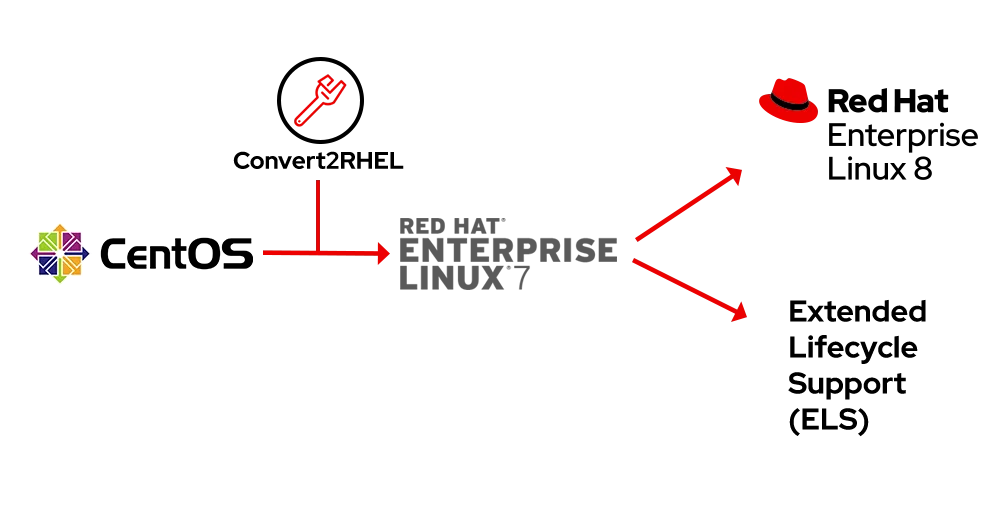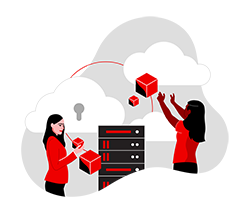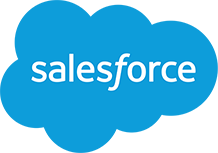Migrate from CentOS Linux to Red Hat Enterprise Linux
Special pricing is available for a limited time
CentOS Linux end of life
CentOS Linux 7 reached end of life (EOL) on June 30, 2024.
Organizations running CentOS Linux must migrate to a new operating system (OS) to continue receiving updates, security patches, and new features. Support provided by third parties would be a fork, and wholly separate from the CentOS Project, CentOS Stream, or Red Hat.
If you’re on CentOS Linux 7, this means your systems are now exposed to significant risks. Red Hat® Enterprise Linux® offers built-in security features to help protect your systems against malicious actors, and we can help you plan your move back to safety.
If you’re on CentOS Linux 7, now is the time to prepare and get your migration plans in place
Affordable cost options
With Red Hat Enterprise Linux, you could qualify for one of the following low-cost and no-cost subscription options.
Red Hat Enterprise Linux for Third Party Linux Migration
A cost-effective subscription designed for a smooth transition from CentOS Linux. It offers simplified conversion to Red Hat Enterprise Linux 7 with security updates for up to four years past CentOS EOL. And it’s available on major cloud marketplaces.
Red Hat Enterprise Linux for Microsoft SQL Server Workload Migration
A specialized, cost-effective subscription for Microsoft SQL Server users transitioning from CentOS Linux. Includes tools for smooth configuration and management on Red Hat Enterprise Linux.
Red Hat Developer Subscription for Teams
No-cost Red Hat Enterprise Linux for development use within existing Red Hat customer organizations. Includes support resources and management tools.
Red Hat Developer Subscription for Individuals
A no-cost offering for individual developers to build and test applications.
Red Hat Academic Program
Discounted offer for academic and research institutions, providing a reliable foundation for IT education and innovation.
Red Hat Open Source Infrastructure Subscription
No-cost offer for open source projects and communities, providing a stable foundation for innovative software development.
Why migrate to Red Hat Enterprise Linux
Red Hat Enterprise Linux is a fully supported, production-grade OS available on premises and in the cloud. It’s the best long-term migration option for production use.
Similar user experience, more value.
Because CentOS Linux was derived from Red Hat Enterprise Linux sources, users migrating to Red Hat can continue to use many of the same techniques and elements with minimal training, while also gaining more features, tools, support, and value.
Open hybrid cloud
Red Hat Enterprise Linux provides consistency across open hybrid cloud environments, whether organizations are deploying new applications, moving existing workloads and applications from the datacenter to the cloud, or migrating from another Linux distribution.
Converting CentOS Linux to Red Hat Enterprise Linux
Features and benefits
Cost savings
Red Hat Enterprise Linux has a lower total cost of ownership (TCO) over time, streamlining conversion, maintenance, and overall management for your IT team. According to IDC, organizations that purchase Red Hat Enterprise Linux subscriptions versus using a free, unsupported OS see a greater return on investment, with a 540% three-year ROI.
Cloud provider committed spend programs
If your instances are in the public cloud, take advantage of committed spend programs with AWS, Microsoft Azure, and Google Cloud. Qualifying organizations can also benefit from the Red Hat Hybrid Committed Spend program, which spans multiple cloud partners and includes on-premise deployments.
Certified for SAP HANA
Red Hat Enterprise Linux is one of only two OS options certified for integration with SAP S/4HANA®. It provides the secure, scalable, and reliable OS foundation you need to support the specific requirements of SAP business critical workloads.
Streamlined migration with minimal disruption
The Red Hat migration tool, Convert2RHEL, enables a streamlined migration by automatically determining the conversion path based on the CentOS Linux version. It prepares the system for conversion and replaces CentOS Linux packages with Red Hat Enterprise Linux equivalents while maintaining your customizations, configurations, and preferences.
Analytics, automation and management
Red Hat Enterprise Linux includes built-in analytics, automation, and other tools that increase efficiency and performance. Red Hat Insights is included in your subscription and continuously analyzes platforms and applications to predict risk, recommend actions, and track subscriptions so enterprises can better manage hybrid cloud environments.
Built-in security and compliance capabilities
Security features like kernel live patching, security profiles, security standards certification, and a trusted software supply chain help you meet today’s high security and compliance expectations.
Additional features:
Long-term lifecycle support with up to 10 years of support for major releases and two years of support for minor releases.
Extensive partner ecosystem with 5,000+ certified third-party hardware vendors, 4,500+ certified third-party software vendors, and 1,400+ certified cloud and service providers.
Portability with the ability to move existing Red Hat Enterprise Linux subscriptions to the cloud environment of your choice via Red Hat Cloud Access.
Customer story
Salesforce transitions from CentOS Linux to Red Hat Enterprise Linux 9
The company is migrating over 200,000 systems to streamline IT operations and enhance customer experiences.
How to migrate
Streamline your CentOS Linux migration with Red Hat
Whether you’re using only CentOS Linux or are an existing Red Hat Enterprise Linux customer, and also have CentOS Linux, we have a streamlined migration solution for your needs.
Use the Convert2RHEL tool
Convert2RHEL is a command line utility that converts a RPM-based Linux OS, like CentOS Linux 7, to a fully supported Red Hat Enterprise Linux OS (in this case, Red Hat Enterprise Linux 7).
The do-it-yourself tool provides an automated way to convert to Red Hat Enterprise Linux—instead of manually redeploying all your workloads. Convert2RHEL minimizes the need for costly redeployment projects and reduces administrative burden by maintaining existing OS customizations, configurations, and preferences during the conversion.
Check out our interactive lab for a step-by-step demonstration of how Convert2RHEL works.

After your systems have migrated to Red Hat Enterprise Linux 7, users can either upgrade to Red Hat Enterprise Linux 8 (which can be done in-place), or explore our Extended Lifecycle Support (ELS) subscription.
Use Red Hat Enterprise Linux for Third Party Linux Migration
Red Hat Enterprise Linux for Third Party Linux Migration helps users maintain continuity now that CentOS Linux 7 has reached end of life (EOL). This offering includes tooling and best practices to convert in-place instances of CentOS Linux 7 to Red Hat Enterprise Linux 7. It also allows users to receive software updates and patches for four additional years after the EOL date of June 30, 2024.
Red Hat Enterprise Linux for Third Party Linux Migration is available on the AWS Marketplace and Azure Marketplace.
Use Red Hat Insights
It’s no secret that moving from one Linux distribution to another can be a complex task, but there are steps that can make the process and outcomes more predictable and reduce risk. Organizations migrating to Red Hat Enterprise Linux from CentOS Linux 7 now have a simpler way to convert using Red Hat Insights:
- Register CentOS Linux 7 systems to display in the Insights inventory list.
- Initiate a pre-conversion analysis of selected CentOS Linux 7 systems and receive remediation advice to help address issues that could complicate or prevent conversion to Red Hat Enterprise Linux.
Complete your conversion to Red Hat Enterprise Linux directly from Red Hat Insights after you resolve any issues identified in the pre-conversion analysis. Watch this process in action.
Need help getting started?
Engage Red Hat Consulting to help accelerate your migration or connect with one of our many certified partners.
Frequently asked questions
What is replacing CentOS Linux 7?
CentOS Linux 7 is not being replaced. Updates and releases ended on June 30, 2024.
What is the EOL of CentOS Linux 8?
Updates, patches and new features for CentOS Linux 8 ended on December 31, 2021.
Is CentOS going away?
Updates for CentOS Linux 7 ended on June 30, 2024. However, the CentOS Project and associated community are not going away. Community contributors can continue to collaborate on the development of future versions of Red Hat Enterprise Linux via CentOS Stream, which will remain an important part of the Red Hat Enterprise Linux development process.
Is there a CentOS Linux 9?
There will not be a CentOS Linux 9.



